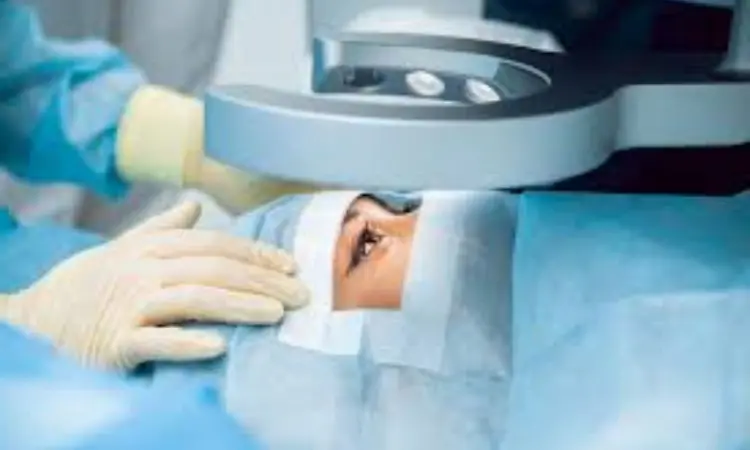- Home
- Medical news & Guidelines
- Anesthesiology
- Cardiology and CTVS
- Critical Care
- Dentistry
- Dermatology
- Diabetes and Endocrinology
- ENT
- Gastroenterology
- Medicine
- Nephrology
- Neurology
- Obstretics-Gynaecology
- Oncology
- Ophthalmology
- Orthopaedics
- Pediatrics-Neonatology
- Psychiatry
- Pulmonology
- Radiology
- Surgery
- Urology
- Laboratory Medicine
- Diet
- Nursing
- Paramedical
- Physiotherapy
- Health news
- Fact Check
- Bone Health Fact Check
- Brain Health Fact Check
- Cancer Related Fact Check
- Child Care Fact Check
- Dental and oral health fact check
- Diabetes and metabolic health fact check
- Diet and Nutrition Fact Check
- Eye and ENT Care Fact Check
- Fitness fact check
- Gut health fact check
- Heart health fact check
- Kidney health fact check
- Medical education fact check
- Men's health fact check
- Respiratory fact check
- Skin and hair care fact check
- Vaccine and Immunization fact check
- Women's health fact check
- AYUSH
- State News
- Andaman and Nicobar Islands
- Andhra Pradesh
- Arunachal Pradesh
- Assam
- Bihar
- Chandigarh
- Chattisgarh
- Dadra and Nagar Haveli
- Daman and Diu
- Delhi
- Goa
- Gujarat
- Haryana
- Himachal Pradesh
- Jammu & Kashmir
- Jharkhand
- Karnataka
- Kerala
- Ladakh
- Lakshadweep
- Madhya Pradesh
- Maharashtra
- Manipur
- Meghalaya
- Mizoram
- Nagaland
- Odisha
- Puducherry
- Punjab
- Rajasthan
- Sikkim
- Tamil Nadu
- Telangana
- Tripura
- Uttar Pradesh
- Uttrakhand
- West Bengal
- Medical Education
- Industry
Better Preoperative visual acuity tied to pseudophakic retinal tears after Cataract Surgery

Cataract Surgery
In a new study published in Ophthalmology Retina, it was shown that patients with higher preoperative visual acuity, longer axial length, and intraoperative difficulties had a higher risk of Retinal Tears (RTs) following cataract surgery.
Cheryl N Fonteh and colleagues undertook this study to examine the prevalence and risk factors for RTs in patients undergoing cataract phacoemulsification surgery, as well as the timing and characteristics of the RTs.
Patients who received cataract phacoemulsification surgery at an academic eye centre in Colorado between January 2014 and December 2019 were included in this retrospective case-control research. A cataract outcomes database was created using data taken from medical document reviews. To account for certain patients who had two eyes in the database, measures of association and P values were calculated using logistic regression models with generalized estimating equations. The detection of RTs within one year of cataract surgery. Demographics, concomitant medical history, ocular features, surgical parameters, and intraoperative complications were used to examine the occurrences of RTs.
The key findings of this study were as follow:
1. The study involved 13 007 cataract procedures, with 79 (0.6%) of the eyes developing RTs within a year of surgery.
2. RTs were more common in men and patients over the age of 65. The RT group had improved preoperative best-corrected visual acuity.
3. Pre-operative high myopia (<=-6.0D) (1.4%) was more common in patients with RTs than in patients with low myopia (-1D and >-6D) (0.7%), emmetropia (1.0D and >-1.0D) (0.4%), and hyperopia (>1.0D) (0.2%), P = 0.0006.
4. RTs were more common in patients who experienced intraoperative problems (4.2% ).
5. The average period between cataract surgery and RTs was 128 days.
6. The majority of RTs were symptomatic (57.0%), situated in the superior hemisphere (83.5%), and were identified concomitant with a retinal detachment (40.5%).
7. According to the multivariable model, intraoperative problems, axial length, and preoperative visual acuity had the greatest relationship with RT.
In conclusion, given the high proportion of asymptomatic RTs and the high likelihood of progression to retinal detachment, careful counseling and surgical follow-up should be recommended for patients identified preoperatively as being at a higher risk of RTs.
Reference:
Fonteh, C. N., Patnaik, J. L., Grove, N. C., Lynch, A. M., & Christopher, K. L. (2022). Predictors of Pseudophakic Retinal Tears at a Tertiary Care Academic Medical Center. In Ophthalmology Retina (Vol. 6, Issue 6, pp. 450–456). Elsevier BV. https://doi.org/10.1016/j.oret.2022.01.010
Neuroscience Masters graduate
Jacinthlyn Sylvia, a Neuroscience Master's graduate from Chennai has worked extensively in deciphering the neurobiology of cognition and motor control in aging. She also has spread-out exposure to Neurosurgery from her Bachelor’s. She is currently involved in active Neuro-Oncology research. She is an upcoming neuroscientist with a fiery passion for writing. Her news cover at Medical Dialogues feature recent discoveries and updates from the healthcare and biomedical research fields. She can be reached at editorial@medicaldialogues.in
Dr Kamal Kant Kohli-MBBS, DTCD- a chest specialist with more than 30 years of practice and a flair for writing clinical articles, Dr Kamal Kant Kohli joined Medical Dialogues as a Chief Editor of Medical News. Besides writing articles, as an editor, he proofreads and verifies all the medical content published on Medical Dialogues including those coming from journals, studies,medical conferences,guidelines etc. Email: drkohli@medicaldialogues.in. Contact no. 011-43720751


